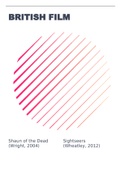BRITISH FILM
Shaun of the Dead Sightseers
(Wright, 2004) (Wheatley, 2012)
, BRITISH FILM
INTRODUCTION:
This bundle contains all the notes I made in both AS level and A
level classes. The British films you are studying may vary, but
some of the information – for example, notes on ideology – may
come in useful.
Sections in this bundle:
Narrative theories
Applying narrative theories to Shaun of the Dead and
Sightseers
Scene analysis
Themes
Ideology
Character analysis of Tina and Shaun, and a comparison
between the two
NARRATIVE THEORIES
There are five narrative theories quest), the Donor (someone who
that you need to know: Classical gives the Hero a useful item), the
Hollywood, Propp, Todorov, Helper, the Princess’ Father, and
Barthes, and Levi Strauss. the False Hero.
The Classical Hollywood structure Todorov’s theory splits a film into
tells the story in three acts. The five sections: equilibrium,
first act is exposition: it disequilibrium, recognition of the
introduces the two sides (usually problem, quest, and equilibrium
the hero and villain) and explains (but different to the start).
what the problem will be. The
second act is elaboration, as Barthes’ theory discussed action
the hero tries to close the code (also known as proairetic
narrative by solving the problem, code) and enigma code (i.e.
but the problem becomes more hermeneutic code). Action code
complex. Finally, there is a are things that are shown to the
resolution, which is usually audience and lead to immediate
where the hero wins. A film may consequences, while enigma
also include a coda, which is a code is any questions that are
short ending to the film that left unanswered, either for a long
shows the rewards the hero gets period during the film, or not
for saving the day. answered at all.
The next theory is Propp’s. He Levi Strauss’ theory was that
2




